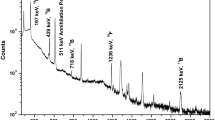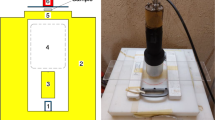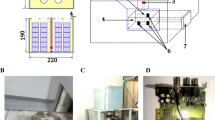Abstract
A Prompt Gamma-ray Neutron Activation Analysis (PGNAA) facility was set up using a thermal neutron beam at Dhruva research reactor. It was utilized for non-destructive quantification of total boron in refractory neutron absorbers and 10B atom% in B4C ceramics having natural and enriched 10B composition by measuring the 478 keV prompt gamma-ray from 10B(n,αγ)*7Li. Self-shielding correction was carried out for higher boron concentration samples using chlorine as an internal standard. As a part of quality assurance, the results of PGNAA were compared with those obtained by in situ current normalized Particle Induced Gamma-ray Emission (PIGE) method.




Similar content being viewed by others
References
Paul RL, Lindstrom RM (2000) Prompt gamma-ray activation analysis: fundamentals and applications. J Radioanal Nucl Chem 243:181–189
Molnar GL (ed) (2004) Handbook of prompt gamma activation analysis with neutron beams. Kluwer Academic Publishers, London
Yonezawa C, Matsue H (2000) Usefulness of prompt gamma-ray analysis with guided neutron beams compared to NAA. J Radioanal Nucl Chem 244:373–378
Acharya R (2009) Prompt gamma-ray neutron activation analysis methodology for determination of boron from trace to major contents. J Radioanal Nucl Chem 281:291–294
Sudarshan K, Tripathi R, Nair AGC, Acharya R, Reddy AVR, Goswami A (2005) Analysis of reference materials by prompt γ-ray neutron activation analysis and evaluation of sample-dependent background. Anal Chim Acta 535:309–315
Sudarshan K, Tripathi R, Nair AGC, Acharya R, Reddy AVR, Goswami A (2005) A simple method for correcting the neutron self-shielding effect of matrix and improving the analytical response in prompt gamma-ray neutron activation analysis. Anal Chim Acta 549:205–211
Zhang Z, Chong Y, Chen X, Jin C, Yang L, Liu T (2015) PGNAA system preliminary design and measurement of In-Hospital Neutron Irradiator for boron concentration measurement. Appl Radiat Isot 106:161–165
Ramanjaneyulu PS, Sayi YS, Newton Nathaniel T, Reddy AVR, Ramakumar KL (2007) Determination of boron in water samples by chemical prompt gamma neutron activation analysis. J Radioanal Nucl Chem 273(2):411–414
Vengosh A, Heumann KG, Juraske S, Kasher R (1994) Boron isotope application for tracing sources of contamination in groundwater. Environ Sci Technol 28:1968–1974
Vengosh A, Spivack AJ, Artzi Y, Ayalon A (1999) Geochemical and boron, strontium, and oxygen isotopic constraints on the origin of the salinity in ground water from the Mediterranean coast of Israel. Water Resour Res 35(6):1877–1894
Acharya R, Sk WR, ChhillarSumit GJ, Sonber JK, Ch MTSR, SasiBhushan K, Rao Radhika M, Majumdar S, Pujari PK (2018) Non-destructive quantification of total boron and its isotopic composition in boron based refractory materials by PIGE and inter-comparison study using TIMS and titrimetry. J Anal At Spectrom 33:784–791
Raja SW, Acharya R, Pujari PK (2020) Applications of PIGE methods for quantification of total boron in neutron absorbers and shielding materials and isotopic composition in boron carbide samples. J Radioanal Nucl Chem 323:1359–1366
Sah RN, Brown PH (1997) Boron determination-a review of analytical methods. Microchem J 56:285–304
Farhat A, Ahmad F, Arafat H (2013) Analytical techniques for boron quantification supporting desalination processes: a review. Desalination 310:9–17
Downing RG, Lamaze GP, Langland JK, Hwang ST (1993) Neutron depth profiling: overview and description of NIST facilities. J Res Natl Inst Stand Technol 98:109–126
Szentmiklósi L, Gméling K, Révay Z (2007) Fitting the boron peak and resolving interferences in the 450–490 keVregionof PGAA spectra. J Radioanal Nucl Chem 271(2):447–453
Riley JE Jr, Lindstrom RM (1987) Determination of boron in borosilicate glasses by neutron capture prompt gamma-ray activation analysis. J Radioanal Nucl Chem 109(1):109–115
Mukhopadhyay PK (2001) Theoperating software of the PHAST PC-MCA card. In: Proceedings of the symposium on intelligent nuclear instrumentation (INIT-2001), Mumbai, India, pp 307–310
Chhillar S, Acharya R, Sodaye S, Pujari PK (2014) Development of particle induced gamma-Ray emission methods for nondestructive determination of isotopic composition of boron and its total concentration in natural and enriched samples. Anal Chem 8:11167–11173
Acharya R, Pujari PK (2018) Development and applications of in situ current normalized PIGE method using proton beams for quantification of low Z elements. J Radioanal Nucl Chem 318:1727–1735
Baechler S, Kudejova P, Jolie J, Schenker J-L, Stritt N (2002) Prompt gamma-ray activation analysis for determination of boron in aqueous solutions. Nucl Instrum Methods Phys Res A 488:410–418
Yonezawa C, Ruska PP, Matsue H, Magara M, Adachi T (1999) Determination of boron in Japanese geochemical reference samples by neutron-induced prompt gamma-ray analysis. J Radioanal Nucl Chem 239(3):571–575
Tzika F, Stamatelatos IE (2004) Thermal neutron self-shielding correction factors for large sample instrumental neutron activation analysis using the MCNP code. Nucl Instrum Methods B 213:177–181
Acharya RN, Sudarshan K, Nair AGC, ScindiaY M, Goswami A, Reddy AVR, Manohar SB (2001) Measurement of k0-factors in prompt gamma-ray neutron activation analysis. J Radioanal Nucl Chem 250(2):303–307
Acharya RN, Nair AGC, Sudarshan K, Goswami A, Reddy AVR (2008) Development and applications of k0 based NAA and prompt gamma-ray NAA methods at BARC. J Radioanal Nucl Chem 278(3):617–620
Acknowledgements
Authors thank Dr. S. M. Yusuf, Head, Solid State Physics Division (SSPD), BARC and Dr. (Mrs.) Mala N. Rao of SSPD, BARC for their support by providing the neutron beam facility at GT Lab, Dhruva reactor for this work. Authors thank Head, MP&CED, BARC and his colleagues for their help and permission to use some of these samples of interest. The results presented in this manuscript are part of Ph.D. thesis work of Sk Wasim Raja under Homi Bhabha National Institute (HBNI). Mr. V. Sharma is thankful to CSIR, New Delhi for Junior Research Fellowship (JRF) and he sincerely thanks Director, RC&IG and Head, RCD, BARC and Principal, K C College, Mumbai for their support and encouragement.
Author information
Authors and Affiliations
Corresponding author
Additional information
Publisher's Note
Springer Nature remains neutral with regard to jurisdictional claims in published maps and institutional affiliations.
Rights and permissions
About this article
Cite this article
Raja, S.W., Samanta, S.K., Sharma, V. et al. Application of PGNAA utilizing thermal neutron beam for quantification of boron concentrations in ceramic and refractory neutron absorbers. J Radioanal Nucl Chem 325, 933–940 (2020). https://doi.org/10.1007/s10967-020-07136-2
Received:
Published:
Issue Date:
DOI: https://doi.org/10.1007/s10967-020-07136-2




